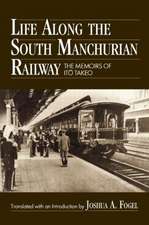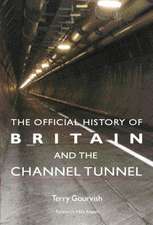Territorial Implications of High Speed Rail: A Spanish Perspective: Transport and Mobility
Editat de José M. de Ureñaen Limba Engleză Paperback – 31 ian 2017
| Toate formatele și edițiile | Preț | Express |
|---|---|---|
| Paperback (1) | 469.34 lei 6-8 săpt. | |
| Taylor & Francis – 31 ian 2017 | 469.34 lei 6-8 săpt. | |
| Hardback (1) | 852.88 lei 6-8 săpt. | |
| Taylor & Francis – 28 iul 2012 | 852.88 lei 6-8 săpt. |
Preț: 469.34 lei
Nou
Puncte Express: 704
Preț estimativ în valută:
89.81€ • 94.02$ • 74.31£
89.81€ • 94.02$ • 74.31£
Carte tipărită la comandă
Livrare economică 05-19 aprilie
Preluare comenzi: 021 569.72.76
Specificații
ISBN-13: 9781138274914
ISBN-10: 1138274917
Pagini: 312
Dimensiuni: 156 x 234 mm
Greutate: 0.45 kg
Ediția:1
Editura: Taylor & Francis
Colecția Routledge
Seria Transport and Mobility
Locul publicării:Oxford, United Kingdom
ISBN-10: 1138274917
Pagini: 312
Dimensiuni: 156 x 234 mm
Greutate: 0.45 kg
Ediția:1
Editura: Taylor & Francis
Colecția Routledge
Seria Transport and Mobility
Locul publicării:Oxford, United Kingdom
Cuprins
Contents: Foreword, Gabriel Dupuy; Preface, José M. de Ureña; High-speed rail and its evolution in Spain, José M. de Ureña ; High-speed rail - the European experience, Roger Vickerman; Territory and high-speed rail: a conceptual framework, Severino Escolano; Demographic and socio-economic context of spatial development in Spain, Pedro Reques, Olga de Cos and Mariá Marañón; Accessibility evaluation of the transportation network in Spain during the first decade of the 21st century, Ãngel Pueyo, Jorge A. Jover and MarÃa Zúñiga; Mobility characteristics of medium-distance high-speed rail services, José M. Menéndez, Ana Rivas and Inmaculada Gallego; Territorial implications at national and regional scales of high-speed rail, José M. de Ureña, José M. Coronado, Maddi Garmendia and Vicente Romero; The high-speed rail in Spanish cities: urban integration and local strategies for socio-economic development, Carmen Bellet, Pilar Alonso and Aaron Gutiérrez; High-speed rail and regional accessibility, Ãngela de Meer, Cecilia Ribalaygua and Elena MartÃn; Economic assessment of high-speed rail in Spain, Vicente Inglada, Pablo Coto-Millán, José Villaverde and Pedro Casares; Afterthoughts: high-speed rail planning issues and perspectives, José M. de Ureña; Bibliography; Index.
Notă biografică
José M. de Ureña, University of Castilla La Mancha, Spain
Descriere
This book presents the experience of 20 years of HSR in Spain including some explicit information, arguments and conclusions derived from HSR in other European Countries. It debates the HSR territorial implications at three scales: national, regional and local, thus being of interest for strategic debates at those scales, such as the decision of new national lines, the pros and cons of deviating the line to reach minor intermediate cities or the selection of precise locations for new stations and the development projects in their surroundings.



















